Abstract
Experiments involving ethylene oxide (ETO) have been used to support the concept of using adducts in hemoglobin as a surrogate for DNA adducts in target tissues. The relationship between repeated exposures to ETO and the formation of N-(2-hydroxyethyl)valine (HEtVal) in hemoglobin and 7-(2-hydroxyethyl)guanine (7-HEG) in DNA was investigated in male rats and mice exposed by inhalation to 0, 3, 10, 33, or 100 ppm ETO for 6 hr/day for 4 weeks, or exposed to 100 ppm (mice) or 300 ppm (rats) for 1, 3, 5, 10, or 20 days (5 days/week). HEtVal was determined by Edman degradation, and 7-HEG was quantitated by HPLC separation and fluorescence detection. HEtVal formation was linear between 3 and 33 ppm ETO and increased in slope above 33 ppm. The dose-response curves for 7-HEG in rat tissues were linear between 10 and 100 ppm ETO and increased in slope above 100 ppm. In contrast, only exposures to 100 ppm ETO resulted in significant accumulation of 7-HEG in mice. Hemoglobin adducts were lost at a greater rate than predicted by normal erythrocyte life span. The loss of 7-HEG from DNA was both species and tissue dependent, with the adduct half-lives ranging from 2.9 to 5.8 days in rat tissues (brain, kidney, liver, lung, spleen, testis) and 1.0 to 2.3 days in all mouse tissues except kidney (t1/2 = 6.9 days). The concentrations of HEtVal were similar in concurrently exposed rats and mice, whereas DNA from rats had at least 2-fold greater concentrations of 7-HEG than DNA from mice.(ABSTRACT TRUNCATED AT 250 WORDS)
Full text
PDF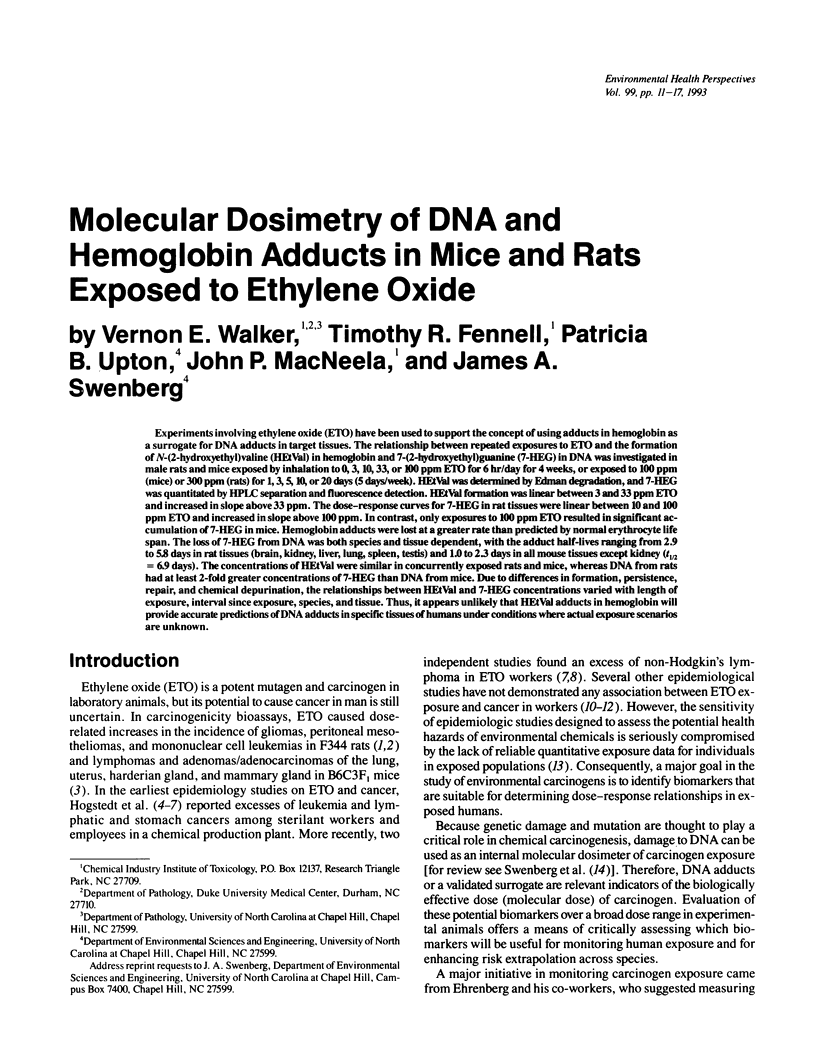
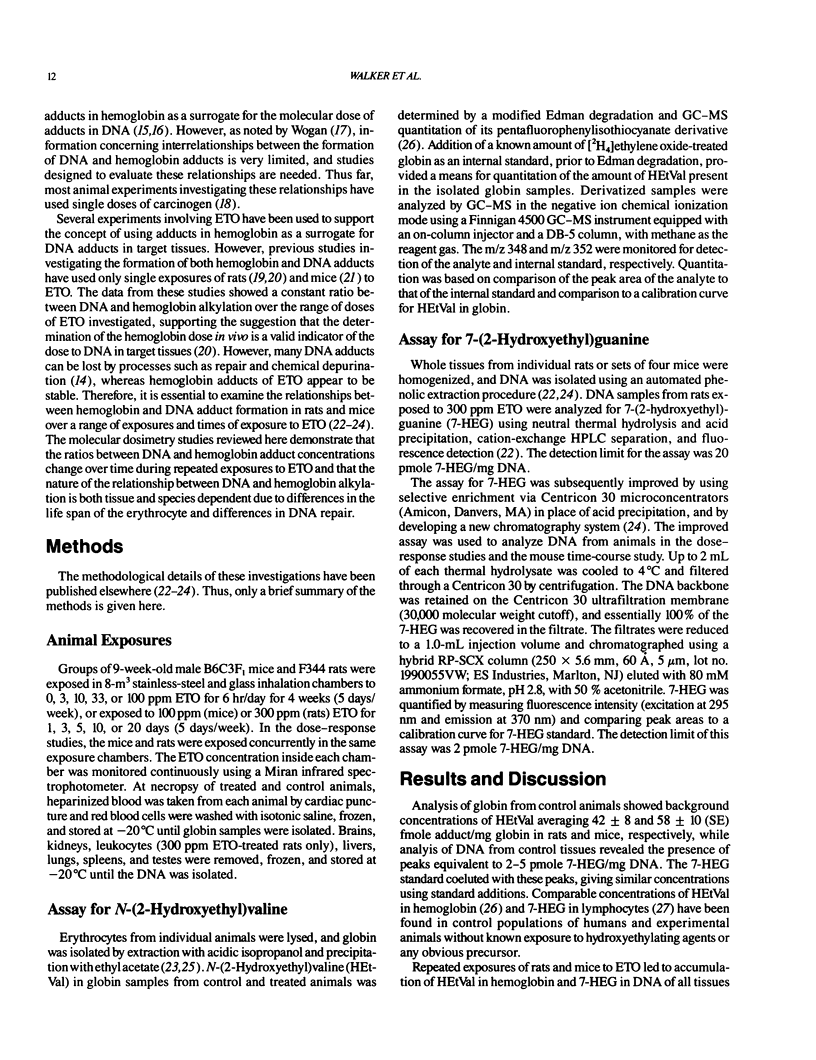
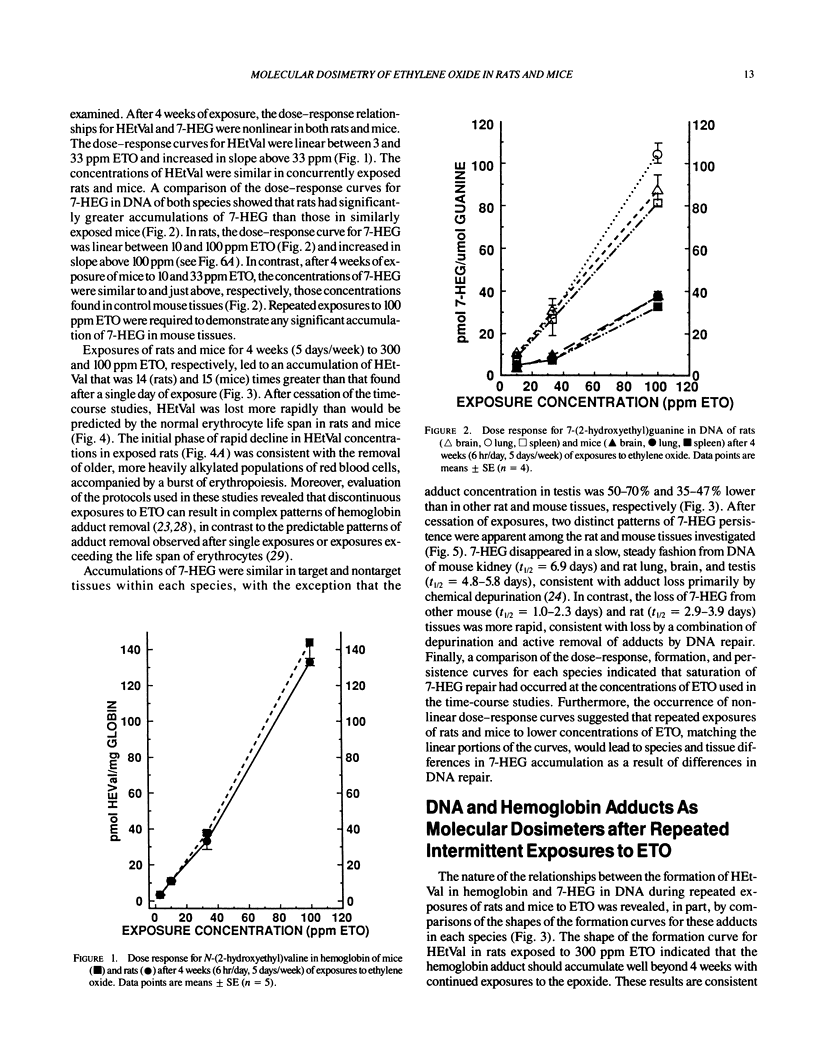
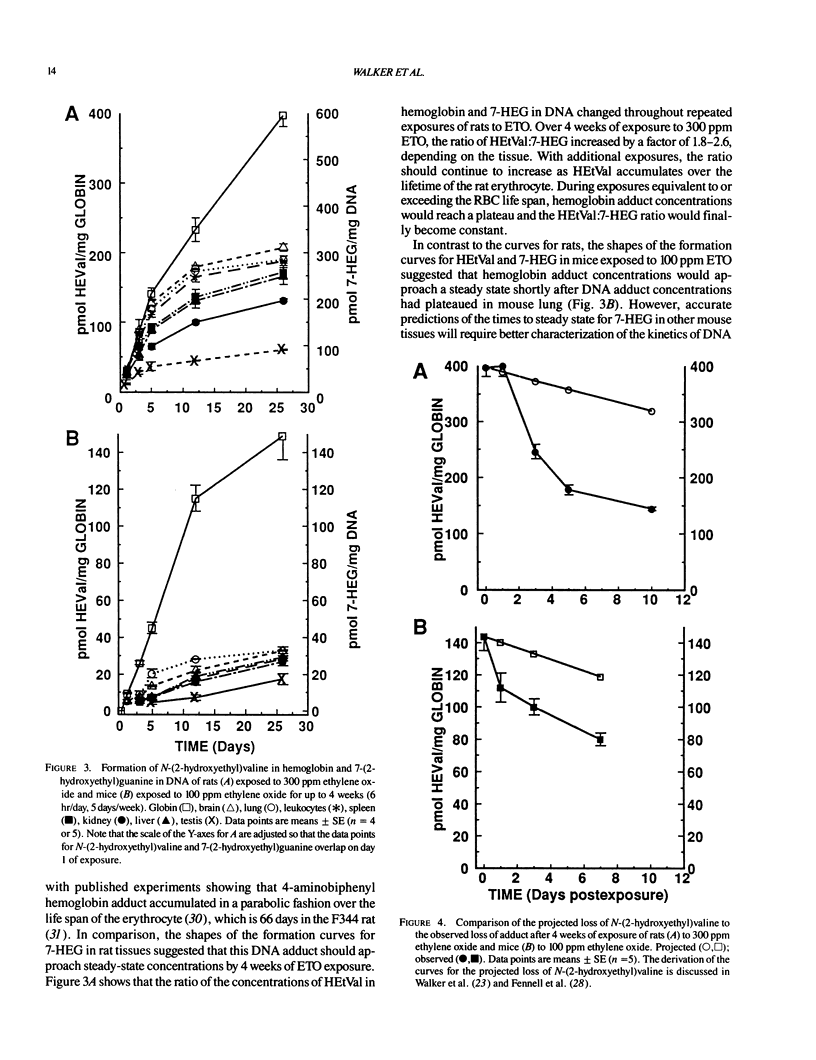

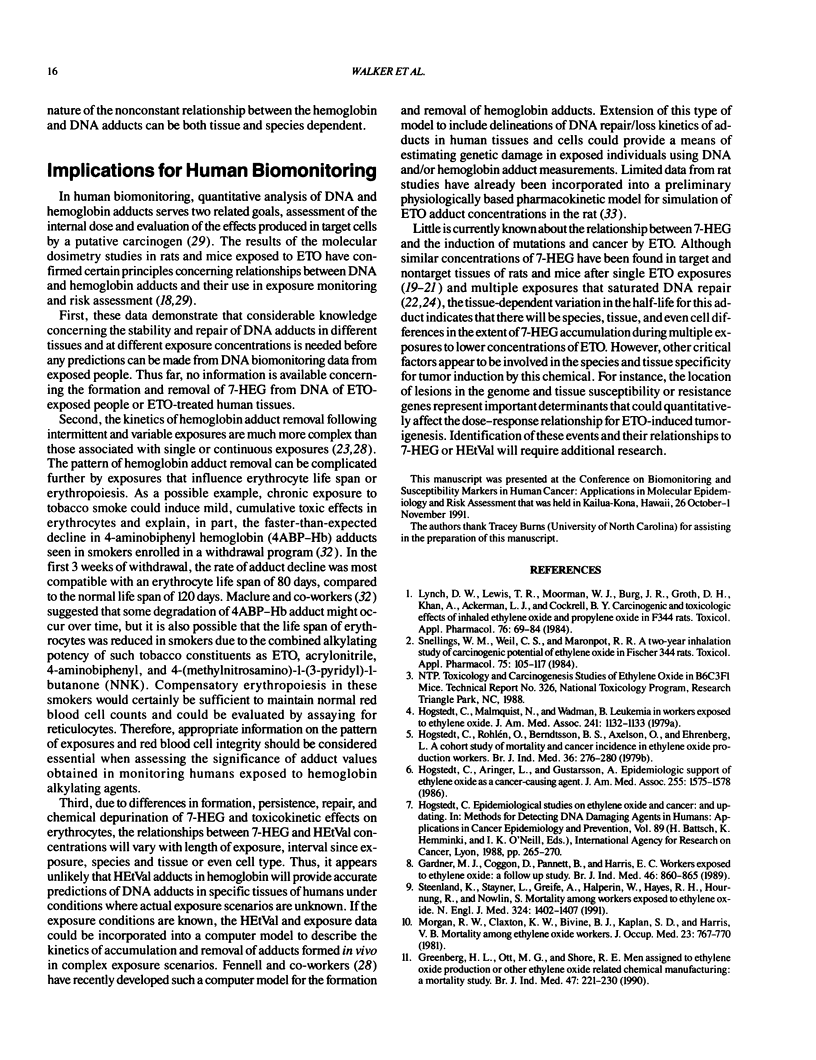

Selected References
These references are in PubMed. This may not be the complete list of references from this article.
- Derelanko M. J. Determination of erythrocyte life span in F-344, Wistar, and Sprague-Dawley rats using a modification of the [3H]diisopropylfluorophosphate ([3H]DFP) method. Fundam Appl Toxicol. 1987 Aug;9(2):271–276. [PubMed] [Google Scholar]
- Ehrenberg L., Hiesche K. D., Osterman-Golkar S., Wenneberg I. Evaluation of genetic risks of alkylating agents: tissue doses in the mouse from air contaminated with ethylene oxide. Mutat Res. 1974 Aug;24(2):83–103. doi: 10.1016/0027-5107(74)90123-7. [DOI] [PubMed] [Google Scholar]
- Fennell T. R., Sumner S. C., Walker V. E. A model for the formation and removal of hemoglobin adducts. Cancer Epidemiol Biomarkers Prev. 1992 Mar-Apr;1(3):213–219. [PubMed] [Google Scholar]
- Föst U., Marczynski B., Kasemann R., Peter H. Determination of 7-(2-hydroxyethyl)guanine with gas chromatography/mass spectrometry as a parameter for genotoxicity of ethylene oxide. Arch Toxicol Suppl. 1989;13:250–253. doi: 10.1007/978-3-642-74117-3_43. [DOI] [PubMed] [Google Scholar]
- Gardner M. J., Coggon D., Pannett B., Harris E. C. Workers exposed to ethylene oxide: a follow up study. Br J Ind Med. 1989 Dec;46(12):860–865. doi: 10.1136/oem.46.12.860. [DOI] [PMC free article] [PubMed] [Google Scholar]
- Green L. C., Skipper P. L., Turesky R. J., Bryant M. S., Tannenbaum S. R. In vivo dosimetry of 4-aminobiphenyl in rats via a cysteine adduct in hemoglobin. Cancer Res. 1984 Oct;44(10):4254–4259. [PubMed] [Google Scholar]
- Greenberg H. L., Ott M. G., Shore R. E. Men assigned to ethylene oxide production or other ethylene oxide related chemical manufacturing: a mortality study. Br J Ind Med. 1990 Apr;47(4):221–230. doi: 10.1136/oem.47.4.221. [DOI] [PMC free article] [PubMed] [Google Scholar]
- Hogstedt C., Aringer L., Gustavsson A. Epidemiologic support for ethylene oxide as a cancer-causing agent. JAMA. 1986 Mar 28;255(12):1575–1578. [PubMed] [Google Scholar]
- Hogstedt C., Malmqvist N., Wadman B. Leukemia in workers exposed to ethylene oxide. JAMA. 1979 Mar 16;241(11):1132–1133. [PubMed] [Google Scholar]
- Hogstedt C., Rohlén O., Berndtsson B. S., Axelson O., Ehrenberg L. A cohort study of mortality and cancer incidence in ethylene oxide production workers. Br J Ind Med. 1979 Nov;36(4):276–280. doi: 10.1136/oem.36.4.276. [DOI] [PMC free article] [PubMed] [Google Scholar]
- Kiesselbach N., Ulm K., Lange H. J., Korallus U. A multicentre mortality study of workers exposed to ethylene oxide. Br J Ind Med. 1990 Mar;47(3):182–188. doi: 10.1136/oem.47.3.182. [DOI] [PMC free article] [PubMed] [Google Scholar]
- Krishnan K., Gargas M. L., Fennell T. R., Andersen M. E. A physiologically based description of ethylene oxide dosimetry in the rat. Toxicol Ind Health. 1992 May-Jun;8(3):121–140. doi: 10.1177/074823379200800301. [DOI] [PubMed] [Google Scholar]
- Lynch D. W., Lewis T. R., Moorman W. J., Burg J. R., Groth D. H., Khan A., Ackerman L. J., Cockrell B. Y. Carcinogenic and toxicologic effects of inhaled ethylene oxide and propylene oxide in F344 rats. Toxicol Appl Pharmacol. 1984 Oct;76(1):69–84. doi: 10.1016/0041-008x(84)90030-9. [DOI] [PubMed] [Google Scholar]
- Maclure M., Bryant M. S., Skipper P. L., Tannenbaum S. R. Decline of the hemoglobin adduct of 4-aminobiphenyl during withdrawal from smoking. Cancer Res. 1990 Jan 1;50(1):181–184. [PubMed] [Google Scholar]
- Morgan R. W., Claxton K. W., Divine B. J., Kaplan S. D., Harris V. B. Mortality among ethylene oxide workers. J Occup Med. 1981 Nov;23(11):767–770. doi: 10.1097/00043764-198111000-00011. [DOI] [PubMed] [Google Scholar]
- Osterman-Golkar S., Ehrenberg L., Segerbäck D., Hällström I. Evaluation of genetic risks of alkylating agents. II. Haemoglobin as a dose monitor. Mutat Res. 1976 Jan;34(1):1–10. doi: 10.1016/0027-5107(76)90256-6. [DOI] [PubMed] [Google Scholar]
- Osterman-Golkar S., Farmer P. B., Segerbäck D., Bailey E., Calleman C. J., Svensson K., Ehrenberg L. Dosimetry of ethylene oxide in the rat by quantitation of alkylated histidine in hemoglobin. Teratog Carcinog Mutagen. 1983;3(5):395–405. doi: 10.1002/1520-6866(1990)3:5<395::aid-tcm1770030502>3.0.co;2-d. [DOI] [PubMed] [Google Scholar]
- Potter D., Blair D., Davies R., Watson W. P., Wright A. S. The relationships between alkylation of haemoglobin and DNA in Fischer 344 rats exposed to [14C]ethylene oxide. Arch Toxicol Suppl. 1989;13:254–257. doi: 10.1007/978-3-642-74117-3_44. [DOI] [PubMed] [Google Scholar]
- Segerbäck D. Alkylation of DNA and hemoglobin in the mouse following exposure to ethene and ethene oxide. Chem Biol Interact. 1983 Jul 15;45(2):139–151. doi: 10.1016/0009-2797(83)90064-9. [DOI] [PubMed] [Google Scholar]
- Skipper P. L., Tannenbaum S. R. Protein adducts in the molecular dosimetry of chemical carcinogens. Carcinogenesis. 1990 Apr;11(4):507–518. doi: 10.1093/carcin/11.4.507. [DOI] [PubMed] [Google Scholar]
- Snellings W. M., Weil C. S., Maronpot R. R. A two-year inhalation study of the carcinogenic potential of ethylene oxide in Fischer 344 rats. Toxicol Appl Pharmacol. 1984 Aug;75(1):105–117. doi: 10.1016/0041-008x(84)90081-4. [DOI] [PubMed] [Google Scholar]
- Steenland K., Stayner L., Greife A., Halperin W., Hayes R., Hornung R., Nowlin S. Mortality among workers exposed to ethylene oxide. N Engl J Med. 1991 May 16;324(20):1402–1407. doi: 10.1056/NEJM199105163242004. [DOI] [PubMed] [Google Scholar]
- Törnqvist M., Kautiainen A., Gatz R. N., Ehrenberg L. Hemoglobin adducts in animals exposed to gasoline and diesel exhausts. 1. Alkenes. J Appl Toxicol. 1988 Jun;8(3):159–170. doi: 10.1002/jat.2550080303. [DOI] [PubMed] [Google Scholar]
- Walker V. E., Fennell T. R., Boucheron J. A., Fedtke N., Ciroussel F., Swenberg J. A. Macromolecular adducts of ethylene oxide: a literature review and a time-course study on the formation of 7-(2-hydroxyethyl)guanine following exposures of rats by inhalation. Mutat Res. 1990 Nov-Dec;233(1-2):151–164. doi: 10.1016/0027-5107(90)90159-2. [DOI] [PubMed] [Google Scholar]
- Walker V. E., Fennell T. R., Upton P. B., Skopek T. R., Prevost V., Shuker D. E., Swenberg J. A. Molecular dosimetry of ethylene oxide: formation and persistence of 7-(2-hydroxyethyl)guanine in DNA following repeated exposures of rats and mice. Cancer Res. 1992 Aug 15;52(16):4328–4334. [PubMed] [Google Scholar]
- Walker V. E., MacNeela J. P., Swenberg J. A., Turner M. J., Jr, Fennell T. R. Molecular dosimetry of ethylene oxide: formation and persistence of N-(2-hydroxyethyl)valine in hemoglobin following repeated exposures of rats and mice. Cancer Res. 1992 Aug 15;52(16):4320–4327. [PubMed] [Google Scholar]


